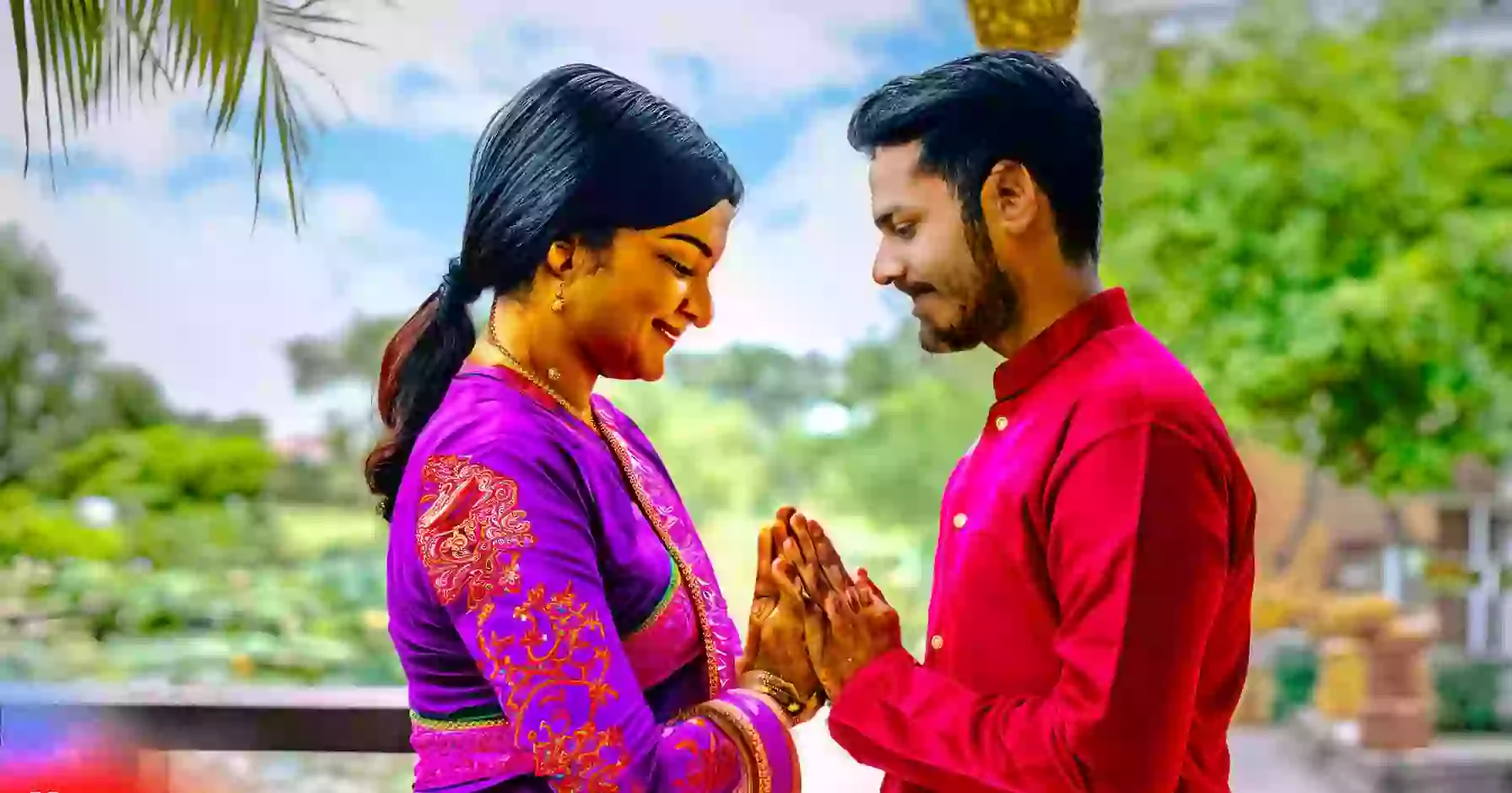The Namaste greeting holds great significance in Indian culture. It is a traditional way of greeting and showing respect in India. In this article, we will explore the deep-rooted meaning behind the Namaste greeting and its cultural significance in Indian society.
What is the significance of the Namaste greeting in Indian culture?
Namaste is a traditional way of greeting in Indian culture. It is a customary Hindu non-contact manner of respectfully greeting and honoring a person or group, used at any time of day
Namaste is usually spoken with a slight bow and hands pressed together, palms touching and fingers pointing upwards, thumbs close to the chest. This gesture is called añjali mudrā. The word Namaste is derived from Sanskrit and means “I bow to you”1.
It is a way of acknowledging ourselves and the person in front of us as a part of the divine creation1. Namaste is a gesture of respect, humility, and acknowledgement of the divine spark within each individual.
It is a way of showing respect and acknowledging the presence of the divine in all beings. Namaste is part of the daily procedure in India and is used as a respectful form of greeting, acknowledging and welcoming a relative, guest or stranger. Namaste is also used to express gratitude for assistance offered or given, and to thank the other person for his or her generous kindness.
What does the word “Namaste” mean?
The word “Namaste” is derived from Sanskrit and is commonly used as a respectful greeting in India and among the Indian diaspora worldwide. It is formed from two words – “Nama” which means bow, obeisance, or adoration, and “te” meaning you. Taken together, “Namaste” literally means “I bow to you” and is an acknowledgment of the soul or spirit of the other person.
It is a highly symbolic gesture that expresses warm sentiments of respect, honor, and friendliness towards another. The underlying meaning behind Namaste is one of unity and interconnectedness, recognizing that we are all part of the same cosmic energy. It is a mindful way to greet and connect with others in a spirit of humility, empathy, and compassion.
2. Is Namaste only used in India?
While Namaste originated in India and remains a commonly used greeting there, its use has spread beyond borders. This reflects the reach of Indian diaspora and the growing popularity of yoga and meditation globally. It is frequently used by non-Indians when greeting people from India or interacting with yoga teachers, for instance.
However, Namaste has not gained mainstream popularity in Western cultures as more casual greetings like ‘Hello’ or ‘Hi’ remain preferred. The deeper spiritual essence behind Namaste may not be fully grasped or valued universally.
Its use outside India is largely restricted to those with connections to or familiarity with Indian culture. However, the universality of its message makes Namaste a unique greeting that can promote unity and understanding across cultures.
3. How is the Namaste greeting performed?
The traditional Namaste greeting is performed by joining the palms together in front of the chest and lightly bowing the head and shoulders while saying “Namaste”. The hand position is important – the two palms should be pressed together with fingers pointing upwards, thumbs close to the chest, and hands approaching the heart.
This symbolic hand gesture is called the Anjali Mudra. While saying Namaste, eye contact should be maintained with the person being greeted out of respect. The light bow is known as Prannamasana and indicates veneration.
Other common aspects include smiling and maintaining a serene headspace. Its a graceful, elegant greeting that epitomizes Indian culture and hospitality. The degree of bowing may vary based on factors like social status, age, and familiarity with the person.
4. What is the significance of pressing the palms together in the Namaste greeting?
Pressing the palms together in Namaste represents the joining or union of two individuals. The hands are our chief instruments of action and by placing them together in front of the heart, it symbolizes the sacrifice of ego and self-interest.
The physical gesture indicates the harmonious meeting of two souls, conveying mutual love, generosity, and respect. It embodies the spiritual concept that we are all one and that the divine light within us honors the divine light in others.
Pressing the palms can also act as a sort of internal ‘mudra’ or energetic seal that promotes feelings of balance, connectedness and wholeness with others. The sound of the two palms coming together is believed to activate chakras and balance vital energy forces.
5. Are there any variations of the Namaste greeting in different regions of India?
There are subtle regional variations in how Namaste is performed across different parts of India:
- In North India, a deeper bow is preferred along with the greeting “Namaste”.
- In Maharashtra, “Namaskar” is used more often than Namaste. The hands are held lower, near the chin rather than the chest.
- Tamil Nadu favors “Vanakkam” over Namaste, with a lighter bow and more space between the palms.
- Kerala uses a similar greeting “Namaskaram” but the bow is even slighter.
- Karnataka favors a formal “Namaskara” with the full bowing ritual.
- Telangana and Andhra Pradesh use “Namasthe” or “Namaskaram” with a deep bow.
The variations extend beyond the depth of bow and terminology used, but the essence and symbolism of Namaste remains largely consistent nationwide.
6. Can you use Namaste to greet strangers?
Yes, Namaste can be appropriately used to greet strangers in India and Indian communities abroad. In fact, it is the customary way to greet someone for the first time. Using Namaste to greet people you don’t know yet reflects the Indian ethos of welcoming guests warmly as an embodiment of the divine.
It immediately diffuses any awkwardness in initial meetings by creating a spiritual bond. Since it is more formal than a casual ‘hello’, Namaste is well-suited for respectfully addressing elders, authority figures and in formal or professional settings.
However, it is not mandatory to greet every stranger with Namaste. In urban areas where social circles are larger, a simple smile or nod may suffice among younger generations.
7. Is Namaste used in formal or informal occasions?
Namaste has a spiritual essence that lends itself well to formal situations, but it is also commonly used in informal daily life. In formal settings like work meetings, religious ceremonies, weddings, or when addressing elders and superiors, using the full Namaste greeting with palms pressed together demonstrates utmost respect and deference.
In informal social situations among friends, family and younger generations, a simple spoken “Namaste” or “Namaskar” without the hand gesture may be preferred.
The fun and casual “Hi-5 Namaste”, bumping palms together in the air, is also increasingly popular among youth. So while deeply spiritual and reverential in meaning, Namaste’s situational flexibility makes it a versatile greeting for both formal and informal use.
8. What is the cultural significance of the Namaste greeting?
Namaste is culturally significant for India and Hinduism in many ways:
- It embodies the ancient Vedic ideal of universal oneness and selfless respect towards others.
- Represents the harmonious interplay between the material and spiritual worlds.
- Epitomizes Indian traditions of hospitality towards guests.
- Denotes sacredness and divinity in relationships.
- Reflects principles of pluralism, tolerance and peaceful coexistence with all.
- Transmits warmth, positivity and goodwill between people.
- Synthesizes India’s cultural and religious diversity through a unified greeting.
- Promotes values of humility, modesty and human dignity.
- Balances the inner and outer worlds and left/right brain hemispheres.
So Namaste profoundly expresses India’s cultural ethos and worldview based on dharma, unity, balance, and mutual interconnectedness of all life.
9. Are there any religious connotations associated with Namaste?
Namaste carries deep spiritual symbolism in Hinduism, Buddhism, and Jainism. Joining the palms in prayer is a mark of respect and veneration. Bowing the head recognizes the divine or sacred essence in all beings. It is used to greet deities and holy persons.
Originating in India, Namaste embodies religious values like ahimsa (non-violence), dharma (ethics), karma (right action), and atma-gyan (self-knowledge). It demonstrates the belief that we are all equal children of God.
However, Namaste does not belong to any one religion. It is India’s universal and unifying greeting, also used by atheists and agnostics. The common use simply reflects respect and recognition of shared divinity. So while having spiritual connotations, Namaste is cultural rather than religious.
10. How does Namaste compare to other greetings in Indian culture?
Namaste holds a unique place in Indian culture compared to other common greetings:
- More formal and spiritual than causal “Hi” or “Hello”.
- Reciprocal compared to respects paid to elders like touching feet (pranam).
- Universal compared to religion or region-specific greetings like “Jai Shri Krishna”, “Salaam Alaikum”.
- Humble compared to greetings with titles like Pranam Maharaj, Namaskar Didi.
- Unifying compared to greetings in local languages like “Vanakkam”, “Nomoshkar”.
- Philosophically richer compared to friendly phrases like “How do you do”.
- More intimate than impersonal nods or handshakes.
So while Indian culture has many greetings, Namaste stands out for combining respect, humility, intimacy, universality, and spiritual depth in a graceful gesture.
11. Is Namaste used by people of all ages in India?
Namaste has traditionally been used by people across all age groups and communities in India. However, globalization has impacted greeting norms:
- Elders and middle-aged adults use Namaste regularly as a sign of respect.
- Younger generations in urban areas greet casually with “Hi/Hello” among peers but use Namaste formally.
- Children learn Namaste as part of culture and use it with elders but not friends.
- Traditional remote communities like villages may rely solely on Namaste for greeting.
- Elders may consider casual greetings disrespectful so young people code-switch between Namaste and modern slang.
- Traditionalists insist on using Namaste exclusively despite globalized influences.
So while deeply ingrained across generations, Namaste’s usage has evolved among youth based on social contexts. Yet it remains an integral aspect of Indian etiquette.
12. Can you use Namaste to bid goodbye to someone?
Yes, Namaste is considered an appropriate greeting for both welcoming and bidding farewell in Indian culture. Just as it is used to say hello, Namaste can be used when saying goodbye. The same warm sentiments of friendliness, humility and respect are conveyed in both instances.
When parting, the Namaste gesture takes on a special meaning – by bowing to each other, it is like we are laying down our egos before separating. Pressing the palms together one final time pays homage to the inner divinity of the other person.
Saying “Namaste” as we leave invokes well-wishes for the other person and an optimistic desire to reconnect again. So Namaste is fitting for both the beginning and ending of an interaction, encapsulating the circular nature of relationships.
13. Are there any specific rules or etiquette associated with Namaste?
Namaste represents etiquette and respect. The main rules regarding its use include:
- Should be practiced with humility focusing on the divinity in others.
- Extent of bowing and posture depends on social seniority of the person.
- Proper Anjali mudra form of palms should be maintained.
- Head should be bowed while saying Namaste.
- Eye contact should be maintained.
- Pleasant smile is important as it sets the tone.
- Do not rush, pause briefly between joining palms and bowing.
- Hands should not be raised higher than chest level.
- Greet both entering and exiting a room or encounter with Namaste.
- Receive Namaste greetings with equal warmth.
- Avoid casual fist bumps or high-fives in place of Namaste.
Following this mindful etiquette enhances the meaningful experience of sharing Namaste.
14. What is the historical origin of the Namaste greeting?
The exact origins of Namaste are unknown but it is estimated to have emerged over 5000 years ago in the Indian subcontinent among early Hindu yogis and Buddhist monks. The first mentions are found in ancient Vedic texts that form the foundation of Indian philosophy.
Descriptions of Anjali mudra for focused meditation and spiritual balance are found in texts like the Rig Veda, Atharva Veda, and Upanishads. Reverential greetings like Namaste are mentioned in the ancient Indian epics Mahabharata and Ramayana.
Daily social use of Namaste likely started in the classical age around 400 BCE to 1000 CE when the Indian traditions coalesced. Temple carvings from the 5th century CE Gupta period depict figures with Namaste posture. Its enduring significance over millennia shows the deep roots and priceless value of Namaste in Indian heritage.
15. How does Namaste compare to other greetings in different cultures?
Compared to greetings worldwide, some unique aspects of Namaste stand out:
- Palm press gesture is more intimate than handshakes.
- Head bowing shows deeper respect than smiles or hellos.
- Reflects spiritual outlook unlike casual hi/heys.
- Inclusive of all genders unlike kisses on cheeks.
- Universal greeting unlike sprach specific ones like Hola, Konnichiwa.
- Non-contact so more hygienic than hugs or cheek kisses.
- Based on acknowledging our shared humanity.
- Given equally to all, unlike titles or ranks used elsewhere.
- Devoid of physical intimacy unlike bear hugs or pats on back.
- Centuries old tradition compared to modern ones like high-fives.
So Namaste elegantly combines respect, intimacy, hygiene, spirituality, equality, inclusiveness and timeless wisdom in a symbolic gesture.
16. Are there any variations of the Namaste greeting in different religions?
Namaste is deeply associated with Hinduism and Buddhism. But it is also incorporated in other religions in unique ways:
- Hindus use Namaste alongside their myriad other greetings.
- Jains bow and say “Namaskar” very gently to avoid hurting microorganisms.
- Buddhists include “namo” chants with Namaste to reflect their teachings.
- Sikhs may bow and say “Sat srī akāl” along with Namaste.
- Indian Christians may say “Namaste, Yesu masih ki jai” (Hail Jesus Christ).
- Indian Muslims may prefer the Arabic “As-salamu alaykum” but understand Namaste.
So while nuances exist, Namaste’s universality makes it a shared part of Indian culture beyond just one religion. The common hand gesture bonds diverse faiths.
17. Is Namaste used in everyday conversations in India?
Namaste is certainly used in everyday conversations among Indians, but not in isolation. Namaste functions more as a warm greeting gesture at the beginning and end of conversations rather than throughout.
A typical flow may look like:
- Meet someone: Begin with Namaste greeting.
- Settle into conversation: Switch to casual “Hi/Hello” or direct talk.
- Discuss matters: Have an engaged discussion in regular style.
- Make requests: Use terms like “please”, “thank you”, etc.
- End conversation: Part with Namaste again.
So Namaste establishes a respectful mood and also provides a nice bookend. But in between, everyday Hindi or English terms are used to sustain conversations in a comfortable flow. Using Namaste repeatedly in long conversations may seem too formal. Namaste’s spiritual essence is more impactful when used judiciously.
18. Are there any alternative greetings used in Indian culture?
While Namaste is the ubiquitous Indian greeting, other context-specific greetings are also popular:
- “vanakkam” (Tamilhello) in Tamil Nadu.
- “Nomoshkar” (Namaskar) in West Bengal.
- “Khamagani” (How are you) in Assam.
- “Ram Ram” / “Jai Bajrang Bali” in parts of North India.
- “Jai Shri Krishna” among Krishna devotees.
- Touching feet of elders called “pranam”.
- Islamic greeting “As-salamu-alaykum”.
- Tribal greetings like “johar” “dewa rewa” based on region.
- Casual “Hi”, “Hey” in urban youth circles.
So while none match the universality of Namaste, India’s diversity brings wonderful regional and religious variations. The choice depends on context, geography, age, and relationships.
19. Is Namaste used in professional settings?
Yes, Namaste is commonly used in professional spheres across India. It fits well with business etiquette due to its formal and respectful nature. Typical workplace usage patterns include:
- Junior staff greeting senior officials with Namaste daily.
- Colleagues using Namaste at start and end of meetings.
- Namaste to welcome clients/guests when they arrive.
- Leaders using Namaste to set an equitable tone.
- Doctors Namaste nurse and patients. Teachers greet students so.
- Phone conversations open and close with Namaste.
- Namaste concludes formal emails alongside “Regards”.
- Replaces handshakes to prevent spreading germs.
Using the dignified Namaste rather than casual greetings in professional settings demonstrates gravity and enhances goodwill. It energizes Indian work culture.
20. How does Namaste reflect the values of Indian society?
Namaste beautifully embodies the core values of Indian culture:
- Respect and honor for all through bowing.
- Belief in oneness of existence through joined palms.
- Emphasis on spiritual growth over ego.
- Equality and humility regardless of class or status.
- Compassion and mutual care through warmth of gesture.
- Harmony and coexistence between different faiths and people.
- Order through rules of etiquette governing its use.
- Pursuit of inner and outer happiness.
- Prioritizing the needs of society over individual.
- Reverence towards the divine in all creation.
Thus, Namaste neatly expresses Indian philosophy of unity, respect, order, compassion, tolerance and self-inquiry through one elegant greeting.
21. Are there any gestures or body language associated with Namaste?
Beyond the signature palms pressed together, Namaste involves other graceful gestures:
- Face and body turned towards the person fully.
- Head slightly bowed down in humility, not just the neck craning.
- Eyes open and making friendly, non-aggressive eye contact.
- Relaxed shoulders, no stiffness. Arms move gentle and easy.
- A warm, genuine smile is vital to the positive feeling.
- Feet together, grounded posture shows balance.
- Slow, smooth movements devoid of any jerkiness.
- No fidgeting of hands or feet which may distract from meaning.
- Prannamasana bow done seamlessly along with Namaste.
- No rush, take a peaceful moment to connect.
Can you use Namaste to express gratitude?
Yes, Namaste is a wonderful way to convey gratitude and appreciation in Indian culture. Its inherent meaning of recognizing the inner divinity and light in others makes it natural for expressing thankfulness. Ways to use Namaste for gratitude include:
- At the end of conversations, use Namaste with smile to say thanks.
- When someone helps you, show your appreciation through Namaste.
- To politely acknowledge a gift, service or act of kindness.
- Use Namaste when leaving gatherings or someone’s home to convey thanks.
- Adding a slight bow to Namaste shows deeper gratitude.
- When words feel inadequate, Namaste can eloquently transmit your feeling.
- Writing “Namaste” instead of thanks in letters or messages.
The reverential energy behind Namaste lends grace and depth to simple thank yous. It conveys that by helping us, their divine nature is honored.
23. Are there any specific occasions or festivals where Namaste is commonly used?
Namaste is integrated into celebrations of Indian festivals and special occasions:
- Greeting and gifting elders on Diwali, Holi, Raksha Bandhan etc.
- Upon arrival to weddings, naming ceremonies and other functions.
- When receiving Prasad or blessings from priests and elders.
- Entering temples, Gurudwaras, mosques and religious places.
- Beginning Puja rituals by Namaste to deities.
- Guru Purnima celebrations for teachers.
- Farewells from relatives visiting during festivals.
- Meets between community leaders and dignitaries.
- Receiving awards or honors with Namaste.
- Visiting patients in hospitals with fruits and Namaste.
So Namaste adds a layer of respect, auspiciousness and divinity to the celebratory atmosphere during Indian festivals and milestones.
24. Is Namaste used differently based on the gender of the person being greeted?
Traditionally, Namaste is used uniformly to greet both men and women. The same warm sentiment and respectful energy is conveyed regardless of gender. However, some subtle adaptations may be seen:
- Elderly women may initiate Namaste first as a sign of honor.
- Men may bend lower while greeting elderly ladies out of chivalry.
- Firmness of palm press may be softer towards feminine energy.
- Women may use both hands together in Namaste.
- Addition of terms like “didi”, “bhabhi” to Namaste for women.
- In villages, women may save full Namaste for elders only.
But these are not fixed distinctions. In urban India, Namaste is largely gender-neutral. The essence remains recognizing divinity and oneness in all. With sensitivity and etiquette, Namaste gracefully bridges diversity.
25. How does Namaste contribute to the sense of unity in Indian culture?
Namaste powerfully promotes unity in Indian culture through various means:
- It is used universally across regions, languages, faiths, castes and classes.
- Reinforces that we are all equal children of the divine despite other differences.
- Directly connects people through a shared gesture of humanity.
- Generates goodwill, empathy and harmony between diverse groups.
- Reminds that individual happiness lies in collective wellbeing.
- Teaches compassion, respect and coexistence from a young age.
- A daily practice keeping people mindful of cultural ideals.
- Common point of pride and positive identity for all Indians worldwide.
- Simple, equitable act that can be performed by all.
- Bonds the rich spiritual and cultural heritage of India.
So with oneness as its core philosophy, Namaste silently but profoundly unites a pluralistic Indian society.
26. Are there variations of the Namaste greeting in different languages spoken in India?
While the clasped palm gesture remains the same, Namaste takes different names in Indian languages:
- Hindi, Gujarati, Marathi: Namaste
- Tamil: Vanakkam
- Telugu: Namaskaram
- Bengali: Prannam
- Assamese: Nomoshkar
- Kannada: Namaskara
- Malayalam: Namaskaram
- Odiya: Namaskar
- Punjabi: Sat Sri Akaal
- Kashmiri: Namaskar
- Sanskrit: Namah / Namaskaraha
So from North to South, East to West, local languages have adopted Namaste and made it their own. This shows its Pan-India appeal overriding regional diversity. The different versions have blended seamlessly into one Indian identity.
27. Is Namaste used in other South Asian countries?
The use of Namaste extends beyond India to neighboring South Asian countries with close cultural ties and Indic influences:
- Nepal – Being majority Hindu, Namaste is used pervasively with the word “Namaste” itself.
- Bhutan – Namaste is commonly used in the Buddhist kingdom along with the term “Kuzuzangpo”.
- Sri Lanka – The Sinhala greeting “Ayubowan” said with a bow derives from Namaste traditions.
- Maldives – Namaste’s usage is seen especially among Hindu Maldivians.
- Bangladesh – Its Muslim majority favors Arabic greetings but Namaste persists in Hindu pockets.
- Pakistan – Limited to diaspora links as Islam predominates greetings.
So Namaste permeates the SAARC countries although Indian diaspora presence, Hinduism and Buddhism have preserved it more prominently in certain nations than others.
28. Are there any cultural norms or expectations associated with the Namaste greeting?
Certain cultural codes of conduct are loosely associated with Namaste:
- It is not mandatory or expected from non-Indians. A friendly hello suffices.
- But Indian diaspora may expect other Indians to Namaste.
- Elders expect Namaste as a sign of respect from younger folks.
- Strangers should be greeted with Namaste before transitioning to first names.
- Superiors prefer Namaste from juniors in official settings.
- A smile should accompany the gesture.
- Avoid casual substitutes like hi-five or handshakes.
- Reciprocate Namaste when greeted so.
- Rise from your seat if feasible when Namasteing elders.
Adhering to these subtle norms enhances Namaste’s role in fostering harmony and goodwill. But it’s also prudent to feel the context rather than worry about strict rules.
29. How does Namaste compare to other non-contact greetings in different cultures?
Unlike distant waves or nods, Namaste offers a deeper connection:
- More intimate than Japanese bows or Thai wais which keep hands to the side.
- Less stiff than hand-on-heart gesture used in the Philippines or the Netherlands.
- Outward Namaste is warmer than inward prayer-like gesture of Israel.
- Centuries older ritual than the modern peace sign or live-long salute.
- Devoted and spiritual, unlike perfunctory, emotionless gestures.
- Reciprocal, unlike greater bowing by juniors in Korea or China.
- Devoid of rank unlike salutes in military cultures.
- Flexible across genders unlike male hand-kissing in Europe.
So Namaste balances intimacy, egalitarianism, spirituality and universality. A timeless way to transmit our common humanity.
30. Is Namaste used in religious ceremonies or rituals?
Namaste is deeply ingrained in Hindu, Buddhist and Jain religious rituals:
- Aartis start and culminate with Namaste to deities.
- Devotees Namaste each other at temple gatherings.
- Priests and gurus are welcomed with Namaste by disciples.
- Prashad or auspicious offerings are given and received with Namaste.
- Namaste while accepting tilak/vermillion at blessings.
- Leave and return home from pilgrimages with Namaste.
- Conclude rituals like Havans and pujas with Namaste.
- Joining palms in Namaste for sacred chants and mantras.
- The transition between different ritual postures using Namaste.
- Ancient temples display images in Namaste mudra.
Namaste adds sanctity, beauty, and order to religious ceremonies, being passed down over generations.
31. Can you use Namaste to greet someone of higher social status?
Yes, Namaste is the most appropriate way to greet individuals of higher social or professional status in India. This includes:
- Elders and family patriarchs/matriarchs.
- Scholars, gurus and community leaders.
- Government officials and authorities.
- Guests and visitors worthy of honor.
- Bosses, managers, and workplace seniors.
- Clientele and customers.
- Priests and religious figures.
- VIPs and dignitaries.
For higher-status people, Namaste is done by standing up with a deeper bow and humility. It may be accompanied by formal titles conveying respect. The underlying message is recognizing their greater worldly wisdom and experience. Using Namaste mindfully elevates interactions between diverse social strata.
32. Are there any health benefits associated with the Namaste greeting?
Yes, when done mindfully, the Namaste gesture is said to have physical and mental health benefits:
- Joining palms centers and channels energy flow in the body.
- The mudra balances hemispheres of the brain.
- Bowing stretches the spine and neck preventing pain.
- The posture tones shoulder, chest and arm muscles.
- It regulates breathing aiding respiratory health.
- Hand gestures increase finger dexterity and strength.
- Circulates blood to the head and face improving circulation.
- The zen act reduces stress and anxiety.
- Connecting to others benefits emotional health.
- Building social bonds counters depression.
So regular Namaste helps integrate mind-body health and social wellbeing based on ancient yogic wisdom.
33. How does Namaste contribute to the hospitality culture in India?
Namaste forms the essence of Indian hospitality and welcoming in many ways:
- Strangers are treated like honored guests through Namaste.
- Immediately diffuses potential tensions or awkwardness with warmth.
- The first gesture to greet outsiders into homes or gatherings.
- Sacred chant “Atithi Devo Bhava” (Guest is God) embodied in Namaste.
- Hosts give Namaste when serving food/drinks to make it satwik.
- Thanked with Namaste for providing hospitality.
- Namaste makes all-inclusive and respected regardless of background.
- Denotes India’s openness to diversity through respectful greetings.
- Ideal for service industry bridging guests and providers.
Thus, Namaste underpins the Indian ethic of generous hospitality considering all visitors as embodiments of the divine.
34. Are there any variations of the Namaste greeting based on the time of day?
There are no strict conventions linking Namaste to different times of the day. The same gesture is appropriate around the clock. However, some broad patterns connect Namaste to daily rhythms:
- It is ubiquitously used in the mornings to start the day well.
- Afternoon Namaste may be accompanied by greetings like “Shubh ahvad” (Good afternoon).
- Evening Namaste often coincides with aarti rituals.
- Nighttime Namaste comes with “Shubh ratri” (Good night).
- Late-night Namaste less common but can acknowledge late meetings.
- Temple goers Namaste the sun at dawn and dusk.
- Yogis Namaste the rising and setting sun during Surya namaskars.
So while variations based on clock time are minimal, Namaste meshes beautifully with the cyclical flow of daily life.
35. Is Namaste used differently in urban and rural areas of India?
Namaste usage differs subtly between rural and urban contexts in India:
Rural villages:
- Used more frequently and exclusively for greeting.
- Elders expect Namaste from youngsters diligently.
- Bowing is deeper as status differences are marked.
- Given to all villagers, known and unknown.
- Less choice of alternative greetings.
Urban cities:
- Used along with English/vernacular casual greetings.
- Reserved more for formal occasions than daily use.
- Shallower bows between relative equals or colleagues.
- Strangers may just get a smile instead of full Namaste.
- Hi-five and handshakes are also popular among youth.
So rural India aligns more closely with the roots of Namaste while urban melting pots add flexibility to its use.
36. Are there any specific hand gestures or positions associated with Namaste?
The signature gesture of Namaste is the Anjali Mudra formed by joining the palms together:
- Palms pressed together in front of the chest, near the heart.
- Fingers pointing up towards sky.
- Thumbs close to the chest, lightly touching sternum.
- Wrists are straight and squared.
- Elbows relaxed by the side of the body.
- Hands equal level, not one higher than the other.
- Palms should gently press together, not just limp fingers.
- Eyes open gazing straight ahead.
- Finishing with a smooth Prannamasana bow.
Mastering the mechanics and energies flowing through precise hand positions is key to correct Namaste.
37. How does Namaste promote mutual respect and understanding?
Namaste beautifully fosters respect and understanding between people through various channels:
- Starts conversations on a humble note byseeing divinity in each other.
- Bowing subdues egos, arrogance and inequality.
- Joining of palms finds spiritual common ground.
- Positive vibration sets the tone for amicable exchange.
- Diffuses potential tensions or conflicts.
- Moves past surface identities to shared humanity beneath.
- Teaches compassion, dignity, patience.
- Physical gesture breaks barriers and inhibits.
- Uplifts lowly and humble the prideful.
- Simple enough for a child to emulate and learn.
Thus, the deceptively simple Namaste gesture silently cultivates values that bind society in harmony.
38. Are there any cultural taboos or restrictions associated with Namaste?
Namaste is an inclusive greeting so taboos surrounding it are rare. However, some considerations exist:
- Avoid greeting deities inside temples with full Namaste which is reserved for priests. A simple join of palms will suffice.
- Do not expect Namaste from those uncomfortable with physical touch or contact. A smile or nod conveys the same respect.
- Refrain from imposing Namaste on unwilling participants in intercultural settings.
- Elders may consider it inappropriate to replace Namaste with casual ‘high-fives’ or ‘fist bumps’.
- In Islam, avoid mixing Namaste with greetings like As-salamu alaykum.
- Some orthodox or traditional beliefs may forbid men and women who are not related from doing Namaste.
- Balancing respect for tradition while normalizing Namaste across cultures and genders is key.
- Ultimately, inner sentiment matters more than outward expression.
With sensitivity, Namaste positively integrates diverse viewpoints.
39. Can you use Namaste to greet someone from a different cultural background?
Namaste can certainly serve as a warm greeting when interacting with people from different cultural backgrounds. Its inclusive beauty lies in transcending specifics. Ways to share Namaste positively across cultures:
- Brief explanation about meaning if unfamiliar.
- Emphasize it being about honoring shared humanity.
- OK to modify bow depth to comfort levels.
- No imposition, do Namaste after consent.
- Acceptable to substitute with friendly hello or smile.
- Adjust to norms of greeting in their culture.
- Be patient in educating about Indian culture.
- Allow two-way exchanges, learn their greetings too.
With openness, humility and wisdom, Namaste can generate goodwill between diverse peoples beyond just Indians.
40. How has the meaning and significance of Namaste evolved over time?
While the essence of Namaste has remained unchanged, some evolution in its practice has occurred:
- From exclusively religious/ sacred origins to becoming a social greeting.
- From being centered on worship to recognizing divinity in all humans.
- Adapting from using fullNamaste at all times to reserving for formal occasions depending on context and company.
- Regional language adaptations like Namaskar, Vanakkam etc.
- Resistance to imposed changes from orthodox groups.
- Simpler abridged versions like ‘Namaste’ replace full bowing ritual for quicker daily use.
- Teaching and transmission becoming less rigorous over generations.
- Associations like yoga popularize Namaste globally beyond just Indians.
So from Vedic times to the modern age, the practice of Namaste has adapted subtly but its spirit remains immortal.
Conclusion:
In conclusion, the Namaste greeting is more than just a simple hello in Indian culture. It is a gesture of respect, humility, and acknowledgment of the divine spark within each individual.

By understanding the significance of Namaste, we can appreciate the rich cultural traditions of India and foster a sense of unity and connection with others. Consider reading >>>> How Indian Traditions and Customs Contribute to the Country’s Unity in Diversity. to learn more.
I am an accomplished author at Fact Finders Company LLC, a renowned publishing house based in New York City. With a passion for research and a talent for writing, I have contributed to numerous non-fiction titles that explore a wide range of topics, from politics and history to science and technology. My work has been widely praised for its accuracy, clarity, and engaging style. Nice Reading here at Fact After Fact.








